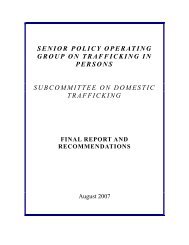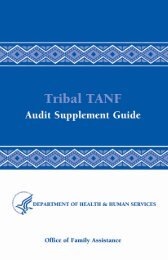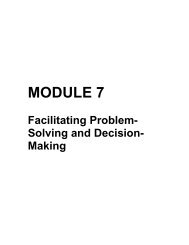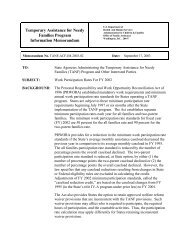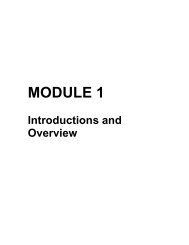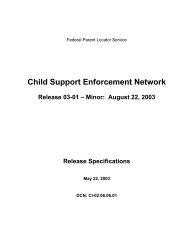Delivering Training and Technical Assistance - Administration for ...
Delivering Training and Technical Assistance - Administration for ...
Delivering Training and Technical Assistance - Administration for ...
You also want an ePaper? Increase the reach of your titles
YUMPU automatically turns print PDFs into web optimized ePapers that Google loves.
TA providers need to ensure that communication about change is consistent. The executive directorshould be in agreement <strong>and</strong> should use the same language to describe the changes taking place as the TAprovider, the board, <strong>and</strong> anyone else involved in the change. This may seem like a minor issue, but theway individuals interpret the meaning <strong>and</strong> impact of a change can vary depending on how the changeis described. All stakeholders should agree on the definition of the change <strong>and</strong> what it means <strong>for</strong> theorganization. If one board member sees the change as simply fine-tuning existing systems while the executivedirector enthusiastically describes the change as revolutionary, mixed messages are inevitable <strong>and</strong> can provecounterproductive to the change ef<strong>for</strong>t.Finally, TA providers <strong>and</strong> the organizational staff they are working with most closely should stay in constantcommunication with both internal <strong>and</strong> external stakeholders. Updates should be provided whenever decisionsare made, as well as along the way.As a TA provider, you are changing the systems used by the beneficiary organization <strong>and</strong> any relationshipsthe organization creates. As an effective TA provider, you should assess an organization’s readiness <strong>for</strong> changebe<strong>for</strong>e the TA engagement <strong>and</strong> manage the change you are facilitating.Summary of <strong>Technical</strong> <strong>Assistance</strong>: Helpful RemindersYour TA ef<strong>for</strong>ts will produce the results you want if you are focused <strong>and</strong> disciplined. A good TA systemwill prevent you from feeling overwhelmed by the needs of the beneficiary organization. Your TA shouldincorporate the core principles listed in the first section, the four phases of a systematic approach listed in thesecond section, <strong>and</strong> the change management tools provided in the third section.DOs• Approach TA in an orderly, professional way• Use the core principles of TA in designing your TAsystem• Provide immediate TA during the request phase,when possible• Try to refer <strong>and</strong> redirect rather than reject requests• Try to meet needs using both on- <strong>and</strong> off-site TA• Begin on-site TA with a briefing <strong>and</strong> end with adebriefing• Define the change when providing TA• Manage change as you provide TA• Check back with organizations you serve after thirtydays• Talk about your procedures <strong>and</strong> look <strong>for</strong> ways toimprove what you doDON’Ts• Begin providing TA without a plan or a system inplace• Tell people to call back in a few months “when youmight know more”• Provide TA without first analyzing need• Visit every organization that requests TA• Assume that indirect TA is inferior to direct TA• Try to serve every beneficiary organization with everyneed they might have• Think you have to do it all yourselfBLENDED LEARNINGWhen providing training <strong>and</strong> TA, some goals <strong>and</strong> objectives lend themselves to in-person instruction whileothers can be effectively achieved through e-learning programs. In such instances, you can incorporate bothmethods of instruction into a “blended” learning program. Blended learning experiences combine e-learning23






